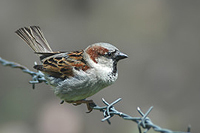Portada del sitio > Fauna > Posible Efecto de la Radiación Electromagnética procedente de Estaciones Base (...)
Electromagnetic Biology and Medicine, Volume 26, Issue 1 January 2007 , pages 63 - 72

Posible Efecto de la Radiación Electromagnética procedente de Estaciones Base de Telefonía Móvil sobre el Número de Gorriones( Passer Domesticus ) en la Epoca de Reproducción/ A Possible Effect of Electromagnetic Radiation from Mobile Phone Base Stations on the Number of Breeding House Sparrows (Passer domesticus)
Viernes 20 de abril de 2007 · 2433 lecturas
Posible Efecto de la Radiación Electromagnética procedente de Estaciones Base de Telefonía Móvil sobre el Número de Gorriones( Passer Domesticus ) en la Epoca de Reproducción
Authors: Joris Everaert a; Dirk Bauwens a
Affiliation: a Research Institute for Nature and Forest. Brussels. Belgium
DOI: 10.1080/15368370701205693
Publication Frequency: 4 issues per year
Published in: Electromagnetic Biology and Medicine, Volume 26, Issue 1 January 2007 , pages 63 - 72
Subjects: Cell Biology; Molecular Biology;
Formats available: HTML (English) : PDF (English)
RESUMEN
Un posible efecto de una exposición a largo plazo a la radiación electromagnética de baja intensidad procedente de las estaciones base de telefonía móvil (GSM) en el número de gorriones durante la época de reproducción fue estudiada en seis barrios residenciales en Bélgica. Se tomaron muestras en 150 puntos de lugares dentro de seis áreas para examinar la variación geográfica a pequeńa escala en el número de gorriones machos y la potencia de la radiación electromagnética procedente de las estaciones base. La variación espacial en el número de gorriones machos estaba negativamente y muy significativamente correlacionada con la potencia de los campos eléctricos transmitidos en bandas de frecuencias de 900 y 1800 MHz y la suma de estas bandas (Chi2-tests y AIC-criteria, P < 0.001). Esta correlación fue muy similar dentro de cada una de las seis áreas de estudio, a pesar de las diferencias entre los valores de potencia de las estaciones base GSM. Así, nuestros datos muestran que fueron vistos menos gorriones machos en lugares con valores de potencia del campo eléctrico de las estaciones de base GSM relativamente altos y por tanto respalda la idea de que una exposición a largo plazo con altos niveles de radiación afecta negativamente la abundancia o el comportamiento de los gorriones en su hábitat natural
Palabras claves : Antena , Pájaro, Radiación electromagnética , Estación base GSM , Efectos no térmicos
A Possible Effect of Electromagnetic Radiation from Mobile Phone Base Stations on the Number of Breeding House Sparrows (Passer domesticus)
Authors: Joris Everaert a; Dirk Bauwens a
Affiliation: a Research Institute for Nature and Forest. Brussels. Belgium
DOI: 10.1080/15368370701205693
Publication Frequency: 4 issues per year
Published in: Electromagnetic Biology and Medicine, Volume 26, Issue 1 January 2007 , pages 63 - 72
Subjects: Cell Biology; Molecular Biology;
Formats available: HTML (English) : PDF (English)
In order to give pricing details we need to know your country. Please register and/or sign in to identify your country.
Abstract
A possible effect of long-term exposure to low-intensity electromagnetic radiation from mobile phone (GSM) base stations on the number of House Sparrows during the breeding season was studied in six residential districts in Belgium. We sampled 150 point locations within the 6 areas to examine small-scale geographic variation in the number of House Sparrow males and the strength of electromagnetic radiation from base stations. Spatial variation in the number of House Sparrow males was negatively and highly significantly related to the strength of electric fields from both the 900 and 1800 MHz downlink frequency bands and from the sum of these bands (Chi2-tests and AIC-criteria, P < 0.001). This negative relationship was highly similar within each of the six study areas, despite differences among areas in both the number of birds and radiation levels. Thus, our data show that fewer House Sparrow males were seen at locations with relatively high electric field strength values of GSM base stations and therefore support the notion that long-term exposure to higher levels of radiation negatively affects the abundance or behavior of House Sparrows in the wild.
Keywords: Antenna; Bird; Electromagnetic radiation; GSM base station; Non thermal effect
Ver el abstract original AQUÍ







